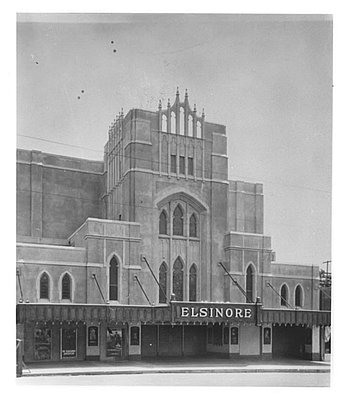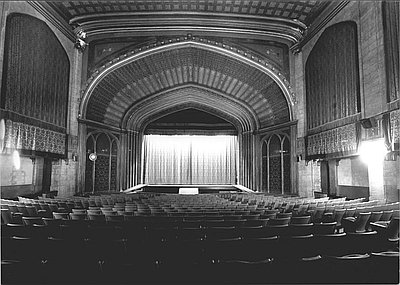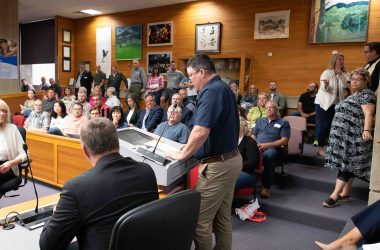
The Ben Maxwell Collection photo’s description (#3896) was:
The two people in the photo are Mr. and Mrs. George Guthrie, taken in September, 1953. Guthrie, whose home was in Portland, Oregon, was former owner of the Elsinore Theatre in Salem. Guthrie was also an outstanding art collector.
It’s fitting that this photo finds George and Caroline Guthrie sitting beneath one of their paintings, “Crater Lake,” by Marius Hubert Robert. The Iowa-born, Harvard graduate George Guthrie practiced law beginning in 1910, but an important part of his life was art, something that continues to live on with his theater, the Elsinore, in downtown Salem.
Guthrie entered the Salem theater business in February 1913, taking over management of the Globe Theater in the Hubbard Building. He renamed the theater the Oregon. He later had interests in the Liberty and Grand theaters. The Hubbard Building, at the southwest corner of State and High streets, continues to be called the Oregon Building, 95 years after the removal of Guthrie’s theater.
According to the Oregon Statesman, Guthrie began acquiring paintings in 1920. Soon after, he used the Oregon to display some of his works. One of the paintings, a Nativity scene, was exhibited in 1922 in the lobby of the Oregon Theater. It later would be shown in the Elsinore, too.
He spared no expense in upgrading the Oregon Theater, much like he would with the construction of the Elsinore, remodeling the space twice, the second time at a cost of $50,000. He added, among other things, the largest pipe organ in the state outside of Portland and lamps that the Oregon Statesman called in its Jan. 25, 1921 edition “a work of art, having been made to order from special designs and from glass specially prepared and decorated. They, in themselves, are worthy of study.”
A few years later, Guthrie set his sights across High Street to build what would later become known as the Elsinore. Again, he would focus on the details while creating a work of art.

Work began in 1925, but costs quickly escalated. Guthrie told the Oregon Statesman in its May 6, 1926, edition: “We are trying to build for Salem a theatre that will be worthy of her for at least some time to come.” The newspaper said completion was months late and was costing nearly three times as much as initially expected, to which Guthrie said: “If we live long enough, may God give us strength to see it done yet.”
The paper shared why it had been so expensive: “Extension of time and expenditure of more money are the result, however, of an endeavor to build the theatre in such a way that it will be of absolutely highest quality in every respect. For instance, Mr. Guthrie has insisted that every bit of the finish plaster be in the best possible shape. In any part of the building, if the finish job is looked the least bit doubtful, the plaster was removed and a new coat applied. The same rule is applied to decorating.”

He chose the name “Elsinore” because “of his fondness for the play “Hamlet” as well as the “euphonic value of the name.” And “Gothic architecture was adopted for two main reasons: first, the style lends the most to soothing relaxation, an important function of the theater, and second, because the architecture is ever in style.”
Later in May 1926, Guthrie teased the Capital Journal about the delay: “We thought we’d get it done by the first of the year. Perhaps we guessed the wrong year.”
As the building neared completion, Guthrie’s artistic tastes were praised in a Capital Journal editorial:
While the architecture is of English Gothic type and the interior of Tudor design, supplementing the grace of cathedral with the elegance of castle, the originality of the builder is apparent in the perfect harmony that modernizes these medieval designs in a way to fulfill the dream of an artist.
This magnificent building, by far the finest in the Northwest, is the creation of George B. Guthrie, whose modesty is only exceeded by his artistry.
The Elsinore, which opened May 28, 1926, also served to showcase his collection.
“Landcapes of remarkable appeal, vivid with color, a seventeenth century North Italian “Nativity” by an artist whose identity has been lost in the centuries, a Venetian moonlight scene by a famous National Academy man, an intimate scene in an Italian peasant’s home, and a brilliant canvas by one of the leading moderns depicting a bit of a French Mediterranean port scene — all these are hung this week against the live brown walls of the lobby of the Elsinore theater,” the Capital Journal reported Dec. 13, 1927.
Guthrie’s involvement in the day-to-day management in the Elsinore ended Oct. 1, 1929, when he leased the building to Fox West Coast Theaters. For the theater’s 25th anniversary in 1951, however, he brought back some of his art to display, which included paintings, a large tapestry and a “fine Kermanshah rug (that was) rehung.”
Different theater groups ran the show until December 1954, when Guthrie sold the building for $175,000 to United Theaters. It cost $250,000 to construct it nearly 30 years earlier.
“Age advances unremittingly, and since Mrs. Guthrie’s passing just a year ago it seemed best to liquidate one’s properties,” Guthrie told the Capital Journal in its December 15, 1954, issue. “We have only the most pleasant memories of this splendid building and the generous support given the venture by the many good and helpful friends in Salem and its vicinity.”

Guthrie died Nov. 27, 1955, of a heart attack at age 73 in Portland. His homes in Portland, Terrebonne and Ocean City “contained many fine creations by leading artists of this nation, England and France. He esteemed conversation pieces by Dutch artists of the 17th century, and his collection contained a number of these as well as landscapes by Ruysdael, Constable and Corot,” the Capital Journal reported Nov. 30, 1955.
He gave paintings to the Salem YMCA as well as the Salem Public Library, while his estate provided one to Bush House.
After his death, the Oregon Statesman reported on other lasting artistic touches Guthrie left on his theater: “In a recent letter, Guthrie revealed a little-known family secret concerning the Elsinore. On the 7th panel from the left in the great Gothic arch above the Elsinore’s stage is fixed the Guthrie family’s ‘coat-of-arms.’
“In both the upper corners of the wall above the arch there are also personal family mementos. In the left corner is the royal coat-of-arms of Scotland — Guthrie’s ancestors came from Scotland. And high on the right corner is the royal coat of Norway — Mrs. Guthrie’s family came from that country.”
The Ben Maxwell Collection consists of more than 5000 photographs donated to the Salem Public Library by the estate of Mr. Ben Maxwell, a noted Salem photographer and historian who died in 1967. Maxwell was a native of Salem, where he was born in 1898. He attended college at Oregon State University where he studied history and journalism. He started working with the Capital Journal newspaper in 1939. Because he packed his camera on every quest for historical stories, he was able to illustrate his articles for readers of the Capital Journal, the Oregon Journal, the Oregonian, and several magazines.
He recorded on film at least 13 governors, old-timers now gone, covered bridges now missing, and buildings and homes no longer standing. The collection includes copies of rare early Oregon photographs taken by others which have in turn been copied over and over by later researchers and feature story writers. This collection is a work in progress and many additional photographs remain to be scanned. The collection can be accessed at: https://photos.salemhistory.net/digital/collection/max
The City of Salem’s Historic Preservation Program staff within the Community Development Department in collaboration with the Salem Historic Landmarks Commission are in the process of completing an inventory of this collection and working to confirm and verify the content and narratives associated with all the photographs in this collection. Please contact Salem’s Historic Preservation Officer, Kimberli Fitzgerald at [email protected] with any suggestions, historic facts, or questions you might have about these historic photos.
STORY TIP OR IDEA? Send an email to Salem Reporter’s news team: [email protected].
A MOMENT MORE, PLEASE– If you found this story useful, consider subscribing to Salem Reporter if you don’t already. Work such as this, done by local professionals, depends on community support from subscribers. Please take a moment and sign up now – easy and secure: SUBSCRIBE.









